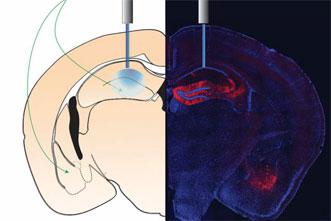
Optogenetics Swaps Memory Emotions
It may be possible to change negative memories into positive ones, and vice versa, using optogenetics techniques.
A team at the Riken-MIT Center for Neural Circuit Genetics looked at how brain structures, such as the hippocampus and the amygdala, collaborate to form memories, and examined whether emotions are stored in the same place in the brain as the memories that cause those emotions.
In the study, mice were placed in a chamber, with some receiving a mild foot shock while others were allowed to socialize, prompting the test subjects to form either a fear or a rewarding memory. The researchers were able to genetically label neurons that were active during the formation of either memory.

The dentate gyrus of the hippocampus (middle) and the basolateral amygdala (bottom corners) were injected with a virus carrying the gene for the light-inducible protein. This image depicts the injection sites and the expression of viral constructs. Courtesy of MIT.
Those same neurons were later activated using optogenetics. The researchers could judge from the mouse's behavior whether the activated memory was fearful or a rewarding one by whether the mice avoided or were attracted to a particular location in the chamber where the memory neurons were optogenetically activated.
“If our technology drives memory engrams, it should work independently of whether the (emotional) valence is negative or positive,” said Dr. Roger Redondo. “We wanted to show that the memory reactivation was not restricted to fear memories, as we had used in the past.”
The mice were then given a new experience with the opposite emotional association while the original memory was activated simultaneously in either the hippocampus or the amygdala. As a result, the memory engram stored in the hippocampus could change its valence. The valence of the memory engram in the amygdala could not be altered, the researchers found.
The study’s findings could explain the success of behavioral therapy for people with phobias, depression or PTSD. New treatments could also be developed for such disorders.
The research was published in Nature (doi: 10.1038/nature13725).
For more information, visit www.mit.edu.
Published: September 2014